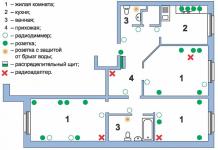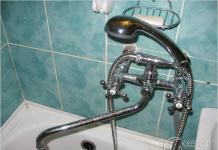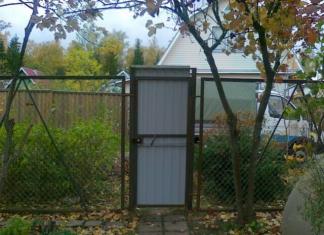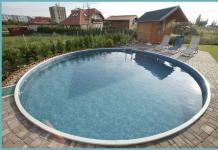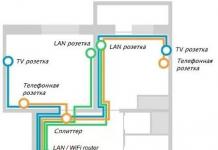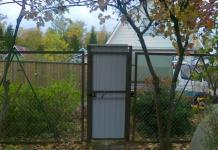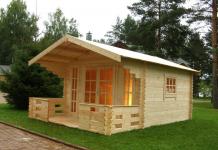The convenience and comfort of modern life largely depends on electricity. In each house or apartment, several household electrical appliances must be used at once to provide lighting, hot water supply, heating, food safety, air conditioning and ventilation. For reliable operation of electrical appliances, competently executed electrical wiring is necessary. Each owner has the right to decide how household appliances will be placed in his home, and where sockets and switches should be located to connect them. But the question is, is it worth using the services of professional electricians when installing electrical wiring, or can you do the electrical wiring in the apartment yourself?
How to start electrical wiring in an apartment
Work on the installation of electrical wiring in an apartment or other residential area should always begin in the same way - with the preparation of an electrical wiring plan. And that's why. Let's say you made a repair without really thinking about the final result. As they wanted, they did it.
Arranged furniture in places, placed consumer electronics. And what did we get? Catastrophe! All sockets were in the "cold reserve": one was blocked by a closet, another by a sofa, a third by a chest of drawers, and a fourth by a bedside table. Even to connect the TV and your favorite stereo system, as according to the law of meanness, there were no sockets within a radius of 3-4 meters.
And here begins a very fun and exciting game called "Scatter extension cords and pilots throughout the apartment." The question is: why did you make new electrical wiring, so that later you could walk and trip over extension cords? Imagine how much money and nerves can be wasted.
Wiring plan
Let's say you have an apartment in a new building, which has yet to be renovated before moving in.
The electrician in the apartment is usually done first. Before starting electrical work, it is desirable to have a wiring plan. In the simplest version, it can be done by hand on a piece of paper.
We draw a wiring plan
So, you consulted with the household and decided. Now we have to transfer all the ideas and plans to paper. We draw a plan of your premises. How to do it? Let's take a standard one-room apartment as an illustrative example.
- To complete the scheme, we need:
- notebook sheet;
- ruler;
- pen;
- colored pencils or markers.
The diagram indicates the location of the walls and doorways. Specific dimensions are not required, only the overall picture is needed.

An example of a wiring plan in an apartment
- The diagram should show the following elements in as much detail as possible:
- Sockets.
They can be located in any convenient place, but not less than 15–20 cm from door and window openings, as well as departing from heat and gas pipelines - 40 cm. As for the quantity, it is customary to install one for every 6 m 2 of area socket. - Lighting.
Standard layouts are designed for one large lamp in the center of the ceiling. But if you wish, you can make additional light sources (spotlights, sconces, nightlights), providing wiring for them. - Switches.
Usually they are mounted on the right side of the doorway and at a distance of 60 or 150 cm from the floor. - Cable laying paths.
When indicating them on your drawing, remember that the wiring must go strictly vertically or horizontally. No zigzags are allowed. If you plan to lay wires inside the walls, then you should retreat from ceilings and openings of 15–20 cm. - distribution boxes.
They also need to be displayed on the plan, because all the main cable connections are made in them. A box is placed on each branch from the main line, but no more than one per room. - Distribution board.
Typically, power cabinets are installed outside the apartment in a common corridor. But some layouts are designed for the internal placement of the shield, in which case the task will be a little easier.
Marking up
One way or another, between the preparation of the plan and the start of rough work, there will be a procedure called "marking".
In scientific terms, markup is the operation of drawing lines (rises) onto the surface of the workpiece, which, according to the drawing, determine the contours of the part or place to be processed.
At the initial stages of work on the distribution of electricity in the room, the markup is carried out as follows:
- first of all, the points of location of sockets and switches, as well as the places for cable outlets for household appliances, are applied to the walls;
- further lines are outlined along which it will be produced;
- places for junction boxes are determined;
- the place where the apartment electrical panel will be installed is selected;
- after that, the routes of cable routes are marked from the distribution electrical panel to a specific electrical point.
In most cases, changes in the wiring diagram of an apartment are easier to make at the initial stage of work, namely at the marking stage. In this case, time and financial resources will be saved, since possible changes will entail additional costs.
- If the electrical panel will be located in the apartment, there are groups:
- lighting of living rooms, kitchens and corridors;
- power supply of living rooms;
- power supply of the kitchen and corridors;
- bathroom lighting and power supply.
If the apartment has an electric stove, it must be allocated to a separate group.
Do not forget to install (RCD) for each group, the so-called differential current switches, to increase safety. Also, they must be supplied with the electrical wiring of the bathroom and kitchen.

After the groups are designed, it is necessary to determine the connection points for all the main consumers of electricity. This is a washing machine, electric stove, air conditioner, water heater, oven and dishwasher.

Now you can determine the installation locations of switches, lamps, junction boxes and sockets, and then apply them to the rough plan of the apartment's electricians. Carefully connect all circuits and mark the lengths of the wires.
Be sure to make an electric plan for the apartment in duplicate and put one of them in the family archive with documents. It will come in handy again and again.
Now a final electrical circuit is being drawn up. To do this, an exact plan of all rooms is depicted on each of the sheets, taking into account all sizes.
All electrical points on the electrical circuit are affixed using generally accepted symbols and connected by lines denoting wires. For better readability, we recommend marking the lighting, grounding and power cables in different colors.
Be sure to mark all the distances: the linear dimensions of the rooms, the distances from the wires to the walls, ceiling, floor, and also to the heating systems. Such a scheme will not only be more visual, but it will be possible to make all the necessary calculations using it.
Requirements, rules, norms
When drawing up a diagram, you should remember some important requirements for the location of electrical wiring in residential premises.
Do not connect the grounding contacts of sockets to neutral wires, as well as to a water supply or heating system. It is dangerous for human life. For this purpose, there is a protective earth wire.
If the apartment has not a gas, but an electric stove, then the main machine must have a rating of at least 63A.
Wires are laid only vertically and horizontally, located strictly at right angles to each other.
You should not change their trajectory, in the future this is fraught with the fact that the likelihood of a breakdown of wires with a nail or drill increases when performing minor repairs. Avoid crossing wires. If this is not possible, then the distance between them should be more than 3 mm.
When setting the dimensions on the plan, it is necessary to ensure that the distance from the cable to the floor or ceiling is at least 150 mm, to window frames, door jambs and corners - at least 100 mm. All switches and sockets should be placed at the same height.
At the same time, switches are installed to the left of the entrance doors at a height of 800-900 mm, and sockets - 250-300 mm. In some cases, such as in the kitchen, the distance may vary. The gap between the heating pipes and wires must be at least 30 mm. Wires to sockets are brought from below, and to switches from above.
Features of the installation of electrical wiring in rooms with high humidity
Until now, it was believed that it was forbidden to mount an outlet in the bathroom. Indeed, the ban existed until 1996. A bathroom is a room with a humid environment, water fittings, a large number of conductive pipelines and a steel bath, which carries an increased electrical hazard.
The ban has long been canceled, partly due to the widespread use of modern electrical safety equipment.
- So the connection of electrical appliances in a room with high humidity is only possible:
- through a residual current device (RCD) with a trip current of not more than 30 mA;
- the electrical wiring must have a connected grounding contact (protective zero TN-S);
- sockets should be located no closer than 60 cm from the doors of a closed shower cabin;
- at a height of at least 130 cm from the floor level.

How to wire correctly
- It is necessary to draw up an electrical wiring plan in the apartment in two copies:
- on the first one, you should draw a plan for the location of switches and lighting equipment;
- and on the second - sockets.
After that, the clients of the electrical circuit should be divided into groups.
- Or like this:
- lighting fixtures for living quarters, kitchen and hallway (automatic 10A);
- sockets in living rooms (automatic 25 A);
- sockets in the kitchen and hallway (25 A machine);
- lights and sockets in the bathroom (these customers are combined into one group, because they work in a humid environment and there are serious requirements for them).
For each household equipment, one group is allocated with a 25 or 32 A automatic machine. The equipment is divided into groups due to some nuances.
If all the equipment that consumes electricity is connected to one machine, then you will need a very thick cable that can withstand such a load. You will also have to buy a machine designed for high power, and this will be quite expensive.
If one of the network elements breaks down, you will have to de-energize the entire apartment in order to start restoration work.
When the electrical wiring diagram in a one-room apartment is ready, it is necessary to determine the number of all electricity consumers. You will have to calculate the required number of outlets based on the number of appliances you already have that are powered by the mains, as well as take into account future purchases.
Then you need to correctly position all sockets and switches.
- To do this, use the following tips:
- switches and sockets should be placed to the left of the door;
- in living quarters and hallway sockets should be at a height of 0.4 meters, in the kitchen at a height of 0.95-1.15 meters;
- switches should be located at a height of 0.9 meters;
- it is necessary to mark the locations of switches and sockets in the circuit.
Then you should run the wires from the switches and sockets (meaning the plan). If you are connecting through junction boxes, then all cables must first go to them, and then to the electrical panel.
- For proper wiring, you need to follow the rules:
- cables must run strictly horizontally or vertically;
- it is better to avoid crossing wires;
- the cable must be mounted at a distance of 0.15 meters from the ceiling and 0.1 meters from doors and windows;
- the cable to the switch is fed from above, the cable to the socket from below.
The last step will be to calculate the footage of cables and the total number of machines. When calculating the cable footage, it is necessary to take into account the dimensions of the rooms, and when calculating the number of machines, one must proceed from the number of groups. It should also be remembered that all machines are eventually connected to one, which is designed for high power.
If you already use or plan to purchase an electric stove, then you need an automatic machine that is designed for at least 63 A.
The main types of wiring
If you decide that the correct electrical wiring in the apartment is up to you, then first you need to choose the method that is suitable for this.
There are three types of wiring:
- using junction boxes;
- star;
- plume.
"Through junction boxes."
This is the most common type of wiring. The electrical panel is located in the stairwell, and not in the living room. A power cable enters from it, and in the shield itself there is a counter and several switches (most often 1-3). In each individual room, power is supplied through a junction box located at the entrance.
"Star".
Each light point or socket is located on a separate cable line that goes into the electrical panel, and often has its own circuit breaker.
Such wiring makes it possible to exercise full control over each element of the power supply chain. Among the disadvantages for the owner is a significant increase in the amount of required wiring and labor costs, the high cost of a fairly large shield, which leads to a significant increase in the cost of the project.

Wiring "Star"
"Plume".
The principle is similar to the “star”, but differs in that not one element, but several, is placed on one cable. The project will cost less than the previous one.
It is rare to find one of the options in its "pure form". In each case, they are mixed to achieve the most effective result.

Combined wiring method
Nuances in a one-room apartment
- In a one-room apartment, most often the wiring is divided into two groups:
- kitchen and bathroom, where a large number of electrical appliances are concentrated;
- living room.
This is done in order to obtain a power reserve by distributing the total load on two circuits, and also so that in the event of a short circuit or open circuit, one line remains in working condition if possible.
Wiring diagram in the apartment (examples)
The above diagram of the apartment wiring of a standard kopeck piece with the location of the electrical panel near the entrance to the apartment is made in a somewhat simplified form. Only the main sources of lighting are presented here, that is, chandeliers, the simplest single-gang switches, hidden sockets with a protective contact for grounding.

So, as you can see for yourself, you can draw up an electrical circuit yourself. A specialist will do this job much better, but each apartment owner must be able to correctly determine the places where the wires pass in order to avoid accidental damage to them by an unsuccessfully driven nail or drill bit.
Installation of electrical wiring in the apartment

Do-it-yourself wiring in an apartment is step-by-step - a matter that requires increased attention to the work performed, strict adherence to safety standards and installation rules.
The slightest mistake can lead to a short circuit. There are a number of specific rules, adhering to which you can make high-quality electrical wiring.
Conducting an electrician is not difficult for those who know how to handle the tool.
Mounting can be done in either of two ways. The hidden laying method includes embedding wiring in walls, ceilings and voids, under flooring, behind plasterboard sheets.
The open installation method includes laying cables in special boxes, cable channels, using brackets, clips. Both of these methods have their advantages. To perform the installation, first of all, it is necessary to move all furniture and household appliances away from the walls and, if major repairs are being carried out, remove all construction debris.
Let's look briefly at each of these stages.
Methods for laying electrical wires and cables
- There are 2 ways to lay electrical wiring in apartments:
- open;
- hidden.
- The latter, in turn, can be divided into:
- ceiling lining;
- laying on the walls;
- and floor padding.
Hidden way
This technology is the most dusty and dirty, as you will have to ditch the walls and ceiling or tear off the flooring. Therefore, it is best to perform it during the overhaul.
If the wiring on the walls is planned in the power supply project, then we put places for wiring on them, pick up a puncher or grinder and cut out grooves of a certain width and depth. We choose the depth based on the fact that after laying the wiring or cable, the plaster layer will be no more than 10 mm, the width is unlimited.
We cut out places for sockets and distribution boxes using a special crown. We remember the load-bearing walls and make strobes not too deep in them. In apartments of panel houses, interfloor ceilings have internal voids in which wiring can be stretched.
Today, monolithic structures with brick interior floors are more popular; in such apartments, strobes are made in all walls, the main thing is not to hook the supporting monolithic beams.
The most economical option for concealed installation is laying under the floor covering. The main thing is the presence of corrugations for each wire. This is done for convenience in case of repair or replacement of wires and for additional insulation.
After the strobes are equipped, they proceed to install the lighting switchboard and lay the cable. The shield itself can be hinged or embedded in the wall. In new houses, a special niche is provided for it, and in old ones it is fixed to the wall with self-tapping screws.
We install automatic machines inside the shield, from which VVG-3 * 2.5 wires will go to sockets and the main highway. From distribution boxes to lighting fixtures, we lay VVG-3 * 1.5. For stationary devices of high power, we make separate lines from the VVG-3 * 2.5 cable. In the places of installation of connection points, we make a release of 15-20 cm.
Now in distribution boxes in a single network. The highest quality connection will be the use of SZ. In order not to confuse the wires during the connection, you can hang tags with a certain marking on them.
After that, using the tester, we check the entire network for damage and errors. If everything is fine, then we wall it up, install switches and sockets in place.
Open mounting
For rooms where it is forbidden or impossible to lay wires hidden, open installation is used (external wiring in the apartment). For these purposes, boxes, cable channels or special clips are used. The laying is quite simple and is carried out only along the walls and ceiling.
The first thing we do is mark the place of laying and drill holes for fasteners in increments of 40-50 cm, if the space for the wire is less than 0.5 m, then we make a step of 15 cm for two fastening points.
After that, we fix boxes, cable channels or clips to the wall or ceiling. At the wiring points, we install external distribution boxes, and wire connections, wiring and installation of connection points are carried out in the same way as in the hidden installation method.
The advantage of open mounting is easy access to all wiring, and the disadvantage is not very aesthetic appearance.

Usually, cables from the distribution room electrical panel are laid along the ceiling (floor slab).
Holes are drilled on the ceiling, then, when laying the cable, a cable fastener is inserted into this hole. I will dwell on this in detail, I will only say that there are many mounting options (for example, a dowel-clamp, dowels with a coupler).
Tools needed for electrical installation
- Before starting the installation of electrical wiring in the apartment, prepare the following tools:
- A wall chaser (or, in extreme cases, a grinder) for chasing furrows, a puncher.
- Screwdriver Set.
- Pliers, cutters.
- Building level.
- Phase indicator.
- Drills, a crown for a puncher for drilling sockets for socket boxes.
- Knife and hacksaw.
In the absence of a professional tool, you can always rent it.
What wire to use for wiring in the apartment
Currently, there is no question - what kind of wire is needed for wiring in the apartment. For the installation of home electrical wiring, wires and cables exclusively with copper conductors are used. Wires and cables with aluminum conductors must not be used for internal wiring.
- Prefer copper wires, as they have:
- increased ductility (less likely to break when laying);
- corrosion resistance (oxidize more slowly);
- long service life compared to aluminum;
- withstand a large load with a smaller cross section.
Wires and cables are single-core and multi-core. Stranded wires and cables have two or more cores reliably insulated from each other in a common sheath.
An example of a stranded wire is a wire of the PRTO brand (a wire with a copper core with rubber insulation in a braid of cotton yarn impregnated with an anti-rotting compound). The cores of single-core and multi-core wires and cables can be made single-wire and multi-wire.
Cables and wires differ from each other in the type of sheath and names. The sheath of wires and cables serves to protect the core insulation from exposure to light, moisture, various chemicals and prevent them from mechanical damage. The structure of the cable may include armor, and the sheath allows them to be laid in more adverse environmental conditions.
Wires can only be laid in a hidden way, with open laying - only in pipes and ducts. Cables can be laid open.
The most popular cable for use in home wiring is VVGng, the NYM cable and PUNP wire are less commonly used.
It is best to use a NYM cable to connect to the floor panel. The same cable is used to connect the floor shield to the apartment or room shields (provided that there are such). Usually such shields are organized in private cottages.
It can also be used for individual connection of powerful consumers. This cable can also be used for all power wiring in an apartment or house, but since it costs more than the VVGng cable and PUNP wire, it is used less frequently for these purposes.
VVG is an unarmored protected cable with copper conductors, PVC insulation, in a PVC sheath. The cable can be used in dry and wet areas.
The VVG cable is not designed for stretching. The insulated conductors of the VVG cable are twisted and have a distinctive color. The inner sheath does not contain filling in the space between the cores.

Cable VVGng
The designation "ng" in the name of the cable (VVGng) means that it does not spread combustion when laid in bundles (a composition based on refractory plastic compound is used). If the VVG cable is used instead of the VVGng cable, then in the event of a fire in one of the cables, the flame will spread to other cables, instead of localizing the fire.
The VVGng cable has a wide variety of shapes. It is most convenient to use a VVGng flat cable. In addition, it can also be round, square, sector, and even triangular.
Cable NUM (NYM) - produced according to the German standard DIN 57250. The cable can be used indoors with hidden and open laying. The NYM cable can be used outdoors, only out of direct sunlight. The NYM cable has low flammability and gas and smoke emission, which is especially important for residential premises.

NYM cable
The NYM cable consists of copper conductors, an intermediate sheath made of chalk-filled rubber and a sheath made of flame retardant PVC insulation. The use of an intermediate sheath in the design of the cable makes it easy and convenient to cut the cable during installation, increases its fire hazard and increases flexibility.
PUNP - installation flat wire. This is the cheapest wire of all cable and wire products used for electrical wiring in everyday life. PUNP wire is produced with two or three single-wire copper conductors and polyvinyl chloride insulation in a sheath made of PVC-compound. The cores can be painted in different colors.

Wire PUNP
PUNP wire is produced only flat. These cable and wire products are used for both power and lighting networks. In the second case, take wires of smaller sections.
Much less often, when wiring home electricians, wires with rubber insulation of the PRN, PRI, PRTO brands are used. Wire PRTO is intended for laying in fireproof pipes, PRI - can be used for laying in dry and damp rooms, PRN (protected wire) - in the open air, PRD, PRHD (two-core twisted wire) - only in lighting networks of dry premises.
For open wiring, it is convenient to use a flat wire with copper conductors and PVC insulation with a dividing base of the PPV brand, as well as a wire with PPP polyethylene insulation. There is a flat wire without a separating base - PPVS, but it is not very convenient to use it.
The previously used wires with aluminum conductors (APR, APV, APRTO, APPV) are now not used in the construction and modernization of home electrical wiring.
Wire with copper core and PVC insulation PV. PV wires can be single-wire and multi-wire. Wires are available with different colors of insulation. In household electrical wiring, a single-core wire PV1 in yellow-green coloring is used for a potential equalization system (DSUP).

Wire PV1
When choosing wires and cables, it is necessary to comply with the requirements of the Electrical Installation Code for the color of the insulation.
The insulation of the zero working conductor should be blue, the zero protective conductor should be yellow-green. The color of the insulation of the phase conductors must differ from the color of the zero ones. There are many options here - brown, red, gray, white, black, etc.
It is also very convenient to use a different color of phase conductors for each section of the wiring, as well as different colors of core insulation for power and lighting wiring.
If you choose and then install electrical wiring with a wire or cable without complying with the requirements for the color of the cores, then in the future this will lead to significant difficulties in maintaining and repairing electricians in the apartment. In addition, the installation process itself can be very complicated, especially when using a large number of switches and sockets.
For different groups of household electrical appliances, wires with different cross sections should be used.
- It would be best to divide the power cables into groups and connect them to separate machines:
- Lighting - wire section from 1.5 mm (automatic - 16 A).
- Sockets - the cross section must be at least 2.5 mm (circuit breaker - 20 A).
- Powerful electrical appliances, such as electric stoves and hobs - at least 4 mm (25 A).
Installation of an apartment electrical panel
Before laying cables, it is advisable to mount the electrical panel in the wall. The size of the shield is selected according to the number of circuit breakers, RCDs, differential circuit breakers that will be installed in it.
The boards are produced in the following main sizes: 4, 8, 12, 18, 24, 36, 48, 60, 72 modules (1 module = 1 single-pole circuit breaker). In an apartment, shields of 12, 24, or 36 modules are usually used.
In my practice of wiring apartments, in most cases I use electrical panels for 24 or 36 modules (24 modules for a 1-room apartment, 36 modules for a 2 or 3-room apartment).
One shield may not be enough if you plan to use equipment for telecommunication networks (router, media converter). In this case, it is rational to place these components in an additional electrical panel, which is installed next to the main (power) panel.
Modern electrical panels are hidden in the wall and do not take up much space.
The advantages of installing an additional electrical panel is that it contains the network equipment that is necessary for the functioning of television and the Internet. Thus, the router, suspended in the hallway on the "carnation" is a thing of the past. Instead, functional and ergonomic solutions come.
Installation of socket boxes and junction boxes
After marking, the places of future sockets and switches became visible. In most cases, in our time, sockets are installed closer to the floor at a height of about 20-40 cm from the floor, switches - at a height of 70-90 cm from the floor.
This rule is not strictly binding, changes are possible upon request. For example, it is more convenient for tall people to use switches located above, for people of short stature, on the contrary, it is better if the switch is placed lower.
Sockets and switches can be assembled in blocks of up to 5 pieces, and sometimes up to 6 in one line. Moreover, both vertical and horizontal installation is possible. All these points should already be taken into account when marking.
And now it remains only to drill recesses in the wall for the sockets. The standard European socket has a diameter of 68 mm. When folding several socket boxes in a row, the distance between their centers should be exactly 71 mm. Depth of socket boxes 45 mm or 60 mm.

Deeper ones are used, for example, for installing a temperature controller for underfloor heating or for switching electrical wires if necessary.
After that, holes for the junction boxes are drilled. Usually junction boxes (they are also called doses) are mounted under the ceiling at a distance of about 15-30 cm from the ceiling. The following rule must be observed: the doses must be on the same vertical axis as the sockets and / or switches located below.
Not everyone likes junction boxes visible on the wall. It is allowed to install junction boxes under the ceiling, provided that the wires are connected by welding or crimping.
wall chasing
Chasing is the process of cutting grooves (recesses, furrows) in concrete, brick or plaster layer for subsequent laying of communications in it (in electrics, communications are electrical cables and wires, in plumbing - pipes).
Before strobe, it is necessary to designate the width and depth of the strobe.
- These parameters are determined based on:
- the number of cables laid together;
- cable sections;
- arrangement of cables in the strobe relative to each other.
On the last point, it is worth clarifying: the cables in the strobe can be laid both flat and in the depth of the strobe. In one case, the strobe is made deeper, in the other, wider. Here, each electrician decides for himself.
You should not make the strobe too wide (with a margin) - during installation, the wire will constantly fall out and it will have to be fixed in the strobe with special clips or “grabbed” with plaster. Ideally, under a wire with a cross section of 1.5 mm, make a strobe 4 mm wide - the cable goes in there with a little interference and holds without problems.
I strongly recommend making strobes with a strobe cutter with an industrial vacuum cleaner connected, and not using a grinder for this. Since fine dust after such chasing will settle down for a long time, which can stall all work.

Professional electricians usually have all these tools (chamber and industrial vacuum cleaner) available. You can rent them if you install them yourself.
Wiring
- Wires can be wired in 3 ways:
- along the ceiling;
- by gender;
- along the walls.
- Electrical wiring on the ceiling is, in my opinion, the best option:
- there is no risk of breaking the wire during repairs;
- there is always an opportunity to get to the wiring.
If necessary, you can always remove the stretch ceiling, make changes to the electrical wiring, and then install the ceiling in place. When wiring on the floor, you will have to hollow out the screed, which is fraught with high costs.
Connection of wires in the junction box
- The main options for connecting conductors in junction boxes:
- twist;
- soldering;
- welding;
- crimping;
- PPE caps;
Please note that only joints made by welding and crimping (as the most reliable) can be walled up according to the PUE.
The cost of electrical work in the apartment
Price list for electrician services:
The average cost of turnkey electrical work
There is another approach when calculating the cost of electrical installation work. The turnkey price is formed depending on the number of installation points.
- All elements are considered points:
- socket;
- switch;
- lamp;
- chandelier, etc.
Prices for electrical installation of one point from 700 to 1500 rubles. (Of course, without taking into account the cost of materials).
Do-it-yourself wiring in the apartment from the shield
Modern requirements for electrical wiring have taken a high bar, as the number of electrical appliances has increased in apartments and houses. Therefore, the wiring must withstand possible loads and comply with safety requirements.
During construction or major repairs, a new wiring diagram in the apartment should be developed, which will take into account the increased human needs for electricity.
According to the new standards, wiring is often thrown along the ceiling
The wiring, which was done in apartments 40 years ago, was calculated for the operation of a small set of appliances - a TV, refrigerator, lighting. The maximum loads were given by electric stoves, kettles and boilers.
Today, people are buying computers, video surveillance systems, powerful home appliances, wireless devices, and more.
At the same time, the principles of designing electrical wiring have not changed, but the network has become more complex and extensive.
Advice! It is important to provide for the optimal number of outlets for appliances that will be used by residents. Otherwise, tees and extension cords will be used, which leads to an increase in loads on individual sections of the wiring and overheating.
 The number of electric outlets has increased
The number of electric outlets has increased An additional difficulty in drawing up a wiring diagram lies in comparing its operating parameters with the power of the devices.
Therefore, you need to know in advance what and where it will stand, and what loads it will exert on the network.
The second point is the correct lighting of the premises, which is carried out in accordance with the standards
Along with the power network, low-current is also used in the apartments. These are television and telephone cables, computer equipment, fiber optic networks, and acoustics. Physically, they cannot be separated, since the devices are connected to them at the same time, which means that the position of the tracks is taken into account when drafting the project.
The amount of cable needed to connect all devices has changed significantly. This also applies to lighting.
Previously, rooms were illuminated with one chandelier, and today spot lighting has come into fashion, which allows you to evenly scatter light over the area of \u200b\u200bthe rooms, as shown in the photo below. Each lamp requires a wire.
 spot lighting
spot lighting Interesting to know! Modern electrical appliances are not as voracious as they used to be. Instead of one incandescent lamp, 10 LEDs can work at once, giving much more light. This fact allows not to overload public networks.
Why do an electrical wiring project in an apartment
To ensure safety, the wires are additionally laid in a corrugated PVC hose, which takes up much more space.
Laying 10-15 cables correctly in a row and spreading them around the apartment is an art. And only a professional electrician acting according to the scheme can cope with the task.
 Someone will say that an electrician is a perfectionist, we will answer that the work was carried out according to the project
Someone will say that an electrician is a perfectionist, we will answer that the work was carried out according to the project The second point is the need to finish and mask communications. After that, it will be impossible to deal with the location of a large number of conductors, without partial damage to the repair.
When the developer has a plan, there are no problems of this kind.
 Apartment wiring plan - example
Apartment wiring plan - example The electrician takes into account the wishes of the client regarding the location of household and heating appliances in the premises, after which he begins to draw up a diagram.
Its task is to break the cables into groups so that they do not intersect, do not interfere with each other, and it is also possible to distribute the load in the network evenly.
He thinks over the protection system (some devices require grounding and the presence of separate RCDs) so that the wiring meets safety requirements.
The electrical wiring diagram includes the following elements:
- Distribution board, which can be intra-apartment or common.
- Electric meter to control the consumption of electricity.
- Automatic protection devices responsible for cutting off the power supply in the event of leakage, human electric shock, short circuits.
- Cables and wires, with the help of which wiring is carried out to electrical outlets.
- Switches and sockets for lighting control and connection of household appliances.
The principle of separation of the intra-apartment network - why is it needed
An introductory machine is installed in the switchboard of a private house or apartment, to which a power cable is connected. This element manages the intra-house network.
When the switch is turned off, electricity is no longer supplied to all points. This is convenient when you need to quickly and indiscriminately de-energize the wires, but it is extremely inconvenient when the light needs to be turned off only in a certain room.
For this reason, the intra-house network is divided into several groups.
 Branching of the intra-house network
Branching of the intra-house network More often, the distribution is done by premises, but there are other principles of division:
- Separate group for lighting.
- Connecting powerful household appliances.
- Separate kitchen line.
- Separate toilet and bath.
Moreover, the network can branch out at several levels, for example, a separate RCD is placed on an electric oven, which will allow other household appliances and lighting to be left in the kitchen if the protection works.
Read also
Layout of houses from a bar
Let's analyze the connection of each group separately.
line for lighting
The light can be turned off separately or by one common switch.
 Multi-level separation of the power circuit
Multi-level separation of the power circuit Important! If there is one chandelier in the living room, and low-power lamps are used in the rest of the rooms, it makes sense to power them together - this will not create a high load on the network.
If the lighting includes a scattering of devices of various types and purposes, then it is worth breaking down into groups - separately the main light source, separately additional spot lighting, and so on.
According to the same principle, it will be possible to separate the premises in which the most powerful equipment is installed. They also act if step-down transformers and various power supplies are installed in the room.
Powerful household appliances
This term refers to those devices that heat something. For example, an electric heating and hot water boiler, an electric stove and an oven. When turned on, they create a high load on the network - 10 Amperes is far from the limit.
 Heating element from the oven can consume up to 4 kW
Heating element from the oven can consume up to 4 kW The socket and wiring should be able to handle this load, as they are designed for loads of 16 amps.
But, firstly, not all sockets and wires, and, secondly, other devices can work in parallel with them.
Turn on the electric kettle at the same time as the oven, and the protection in the shield will probably work, and the line will be de-energized. For this reason, manufacturers of large household appliances recommend a separate connection.
If such a device breaks down, if it is connected independently, it will be convenient for the master to work. You don’t have to look for and reach for the plug, which is usually located in hard-to-reach places.
Kitchen appliances
The reasons are the same as in the case described above. The kitchen network is the busiest. There is a high concentration of powerful electrical appliances.
This includes: washing machines and dishwashers, toasters, microwave ovens, multicookers, bread machines, hoods, grills, meat grinders, water heater, lighting and so on.
 This equipment creates serious loads on the electrical network.
This equipment creates serious loads on the electrical network. Therefore, the kitchen stands out in a separate line, and especially powerful devices have their own RCDs, powered by an introductory machine.
Such a number of devices requires a thoughtful arrangement of outlets. The group is located in the working area so that it is possible to connect mobile devices. Separately, sockets for large household appliances are taken out.
Rooms with high humidity
Previously, sockets were not installed in bathrooms and toilets, but today many devices have been invented for this room.
Using them in a humid environment is dangerous.
For this reason, the room needs other protection devices. The wiring diagram in the bathroom has its own requirements:
- The room junction box must not go inside the room. It is installed in any convenient adjacent room or corridor.
 Junction box on the wall in the hallway
Junction box on the wall in the hallway - Each device that will be used in the bathroom should only be connected to a separate outlet. The use of extensions and tees is not allowed.
 Separate outlet for washing machine
Separate outlet for washing machine - The switch for controlling the lighting of the room is installed, like the box, outside the room. The most convenient place is near the door.
- The electrical cable is laid as close to the ceiling as possible. Be sure to use an insulating corrugation.
 Installation of electrical wiring in the bathroom
Installation of electrical wiring in the bathroom Important! Increased safety requirements are also applied to fittings. The degree of protection must be at least IP 44. In this case, it is recommended to take sockets with a cover that acts as a splash protection.
Interesting to know! This problem remains unsolvable for old-built houses, in which grounding is not provided in principle.
Many people ground equipment to water pipes, but this is not allowed, because of the risk of electric shock, not only to you, but also to your neighbors.
In old houses, sometimes a complete reconstruction of electrical networks is carried out, which allows you to mount an external ground loop. If so, then the residents are lucky - it remains to replace the internal wires.
 Replacing electrical wiring requires a major overhaul
Replacing electrical wiring requires a major overhaul
High-quality electrical lines in an apartment or house are the key to reliable and safe operation. Without special knowledge and understanding of the processes that occur during the distribution of electricity, it is almost impossible to make them yourself, or, in extreme cases, not recommended. However, the services of professionals are now expensive, so many owners are eager to make their own efforts. We'll show you how to do it right.
home electrical network project
A design sketch of the location of cables, sockets and switches is a routine, but extremely necessary work. Without understanding the exact location, it is impossible to arrange a safe home electrician.

The details of the plan are as follows:
- All apartment wiring is divided into groups. So, it is easier to mount, and the system will receive more security in case of an emergency. On the sketch, groups of wires are marked with different markers for convenience and are divided into lighting devices, sockets, junction boxes, power cables and emergency shutdown systems.
- The "humidity" of the room is taken into account. For example, it is necessary to pay increased requirements to the home network in bathrooms, bathrooms and the coldest places in the apartment - hallways, window sills. There is a high probability of accumulation of condensate due to temperature differences in winter.
- The machine responsible for stopping the current is located inside the apartment. Many switchboards are located outside of it, so you have to tinker to equip the control machine inside. Its installation is of great benefit - in case of overvoltage, it will not be difficult to provide an apartment with current supply.
- The entire project is verified in advance, with accompanying provisions from the safety rules. Laying of wires is carried out strictly vertically or horizontally. Applying the length parameters is desirable immediately, so the orientation will go much faster. If there is no knowledge to draw up a quality project, then the document is acquired from specialists.
Methods for installing electrical wiring in an apartment
Until recently, the installation of a home electrical network followed one scenario - the wires were laid on top of the wall finish - wallpaper or plaster. To a certain extent, this was not evident, especially if twisted wire was used - some interiors only benefited from this, retro, for example.
Requirements: installation locations such as skirting boards, corrugated pipes are typical for this type of wiring. Do not lay power and lighting cables together.
Contact surfaces must be made of non-combustible material.
Concealed wiring is more popular. Cables are mounted in strobes - special grooves selected in the wall or located in suspended ceilings.

There are more requirements for the cable than for the open method. Among them: a strong wire body that can withstand not only power loads, but also the thickness of concrete, moisture, mechanical damage, and movement. Corrugation is used for laying - steel pipes cannot be laid in hidden channels.
Do-it-yourself wiring installation
Self-laying begins with the layout of the network, depending on the chosen method. The installation sites of the power unit and the wiring from it are marked.
Tools required:
- Roulette, measuring and control tools - water and laser level. Laying must be carried out carefully, especially when it comes to outdoor installation.
- Wire cutters. All bundles will be hidden in corrugated tubes.
- It is not recommended to purchase metal ones; the wires are placed in a reliable insulating cavity.
- Insulating tape for wire connections. Knife for stripping the ends.
- Bulgarian. It is useful for removing strobes in concrete with a closed method. A chisel is purchased for it, which is convenient to work in soft walls - gypsum, foam block.
- Plaster mortar for grouting. Therefore, you will need a tool for working with the solution - spatulas, graters, mixing containers.

The work will go on in a de-energized apartment, so you should take care of the presence of an extension cord from a live power cable in advance - the wires are disconnected from the meter by connecting a temporary hut. Its length is equal to convenient movement around the apartment.
Installing the inlet shield
If the total voltage is outside the apartment, then only the installation of packet boxes is required - the RCD system (residual current device). It is usually located near the front door, closer to the ceiling. There should be two automatic machines - 16 A for domestic use and 10 A for lighting.
Shtroblenie
Places for future wiring are marked with a marker or pencil. They must be strictly vertical and horizontal lines of the floor or ceiling. Groove width according to the tight entry of the corrugated tube with a bundle of wires - it should not hang out. As well as the depth. A grinder makes cuts in concrete, and then a chisel or chisel is used to grind. The work is carried out carefully so that in the future the cable laying is tight.

In addition to strobes for wires, they are also made for socket boxes. This requires a special round nozzle. If it is not there, then along the drawn circle, concrete or gypsum is knocked out. The work is noisy and dusty, carried out only during daylight hours.
Cutting and laying wires
The length is calculated with a margin of 10-15 cm, so that the ends can be freely connected to each other. Further, laying takes place on the floor - a common cable bundle is inserted into the corrugation, which is inserted into the prepared thickest strobe. Branches will come from it.
A gypsum-based plaster is immediately prepared - it hardens quickly - and little by little, the strobe is closed. Breaks are made every 50 cm, so that the solution has time to set. The ends of the power cable are inserted through the bag into a common shield. Knowledge is required here, so an electrician does the work at this stage. In addition, independent actions are fraught with fines from the resource supplying organization. Call the master for a short time, but less hassle.
Installation of sockets and switches
After the finishing is completed - the strobe is plastered, only the ends of the wires for sockets and the installation of switches look out of the walls, they proceed to their device.
There are several important rules, the observance of which will increase the safety of the home electrical network:
- There should not be sockets near the floor. Calculation for sudden flooding or evaporation of condensate. Low installed ones are more likely to get damp and short out. Therefore, a distance of up to 10 cm is taken into account immediately when laying the strobe.
- The height of the switches has no regulation. However, for a family with small children, this is taken into account - a child at a tender age should not independently reach the subject of interest to him. The height of the student and the free position of the raised hand are taken into account.
- Do not install conductive devices near "wet" sources - bathtubs, sinks. The minimum distance on the kitchen apron is 50 cm, in the bathroom - 2.5 m. This rule also applies to "hot" spots - water heaters, gas stoves, ovens and other similar places. The reason is the melting of the insulation with the release of toxic gas.
- When buying, carefully inspect the offered product - sockets and switches must be completely isolated, otherwise there will be no security. Moving parts are securely fastened. It is good to ask about the availability of a quality certificate.
- Installation of sockets and switches also goes in two ways - hidden and external. The first one is distinguished by special boxes where elements are inserted. The second is ordinary, plastic models are glued or screwed to the wire outlet.

To make your home equipped with high-quality wiring, you should carefully consider the following:
- Replacing the wiring is planned before the repair and preparation of the walls. As can be seen from what has been written, this is laborious work, therefore, it is not advisable to carry it out after the walls have received the finishing cladding.
- Wiring should be planned with full accounting of household appliances. You can't even leave one wall empty. It is quite possible that the idea will come to rearrange the furniture and equipment and the points from where safe food is possible will not be there. A large number of extension cords leads to accidents and injuries.
- Built-in lamps should have simple controls, so the laying scheme is agreed with professionals in advance. Installation of a suspended or stretch ceiling is an expensive pleasure and reworking a failed device will cost a tidy sum.
- It is better to give preference to copper wire than aluminum. Its service life is greatly reduced. In addition, even a new cable is fragile, which is why microcracks appear on its surface during manual installation. Over time, under load and constant temperature changes, they will grow, and the cable will cease to function, which will require its complete replacement.
- Wiring is best with minimal connections. Spikes and twists will quickly fail the entire cable. Special boxes embedded in the walls save from overheating in these places.
The last "parting word" - if there is no understanding and ability to handle dangerous elements, it's not worth the risk. This is fraught with accidents during installation or operation in the future. Professional work is not cheap, but as a bonus, it offers a guarantee that will provide your life with comfort for many years to come.
Video on the installation of electrical wiring with your own hands in the apartment
A cosmetic or private home is a fairly simple process: re-paste, refurbish ... Much more difficult when large-scale work is started. And if conceived, especially in houses that were put into operation more than 20 years ago, you should think about a complete replacement of the wiring. After all, old cables that have served their time are unsafe in operation, and in recent times there has been an increase, which means that the load has also increased. Today we’ll talk about how electrical wiring is done in an apartment or a private house, and about the possibility of doing it yourself.
All work related to the laying, wiring or switching of electrical cables and protective automation must be carried out in strict accordance with the rules for the installation of electrical installations (PUE) and be carried out in compliance with safety standards. Before starting such work, you should prepare everything you need and arrange it so that it is directly accessible.
Important! When installing sockets and switches, the height of their placement from the floor and the switching rules specified in the PUE should be observed. It makes sense to carefully study this document in order to avoid subsequent alterations.

How the wiring is done in the apartment: the basic rules for the production of work
In order for such a task to be completed with high quality, it is necessary to draw up an approximate wiring diagram in the apartment indicating the placement of electrical outlets, and their power consumption, their connection lines. It is during the production of such work that the load is distributed evenly across groups, each of which will be protected by its own separate circuit breaker. In separate lines, household electrical appliances such as and should be singled out. Such devices require the additional installation of an RCD or a residual current circuit breaker.

Methods for connecting wires in junction boxes
Switching electrical wiring in an apartment can be done in three main ways:
- Conventional twisting is a fairly simple, but not always convenient method, the production of which can lead to heating of the joint with a weak pull.
- Soldered twisting - the method is quite laborious and takes a lot of time, but the contact is tight and protected from heat.
- Application . Previously, screw terminals were used for these purposes, requiring additional installation time. Today, WAGO contactors are increasingly common, which allow you to perform electrical work as quickly as possible.

Related article:
: advantages and disadvantages, requirements, varieties, subtleties of choice, an overview of manufacturers, installation technologies, how to connect copper and aluminum wires - read in our publication.
Types of cable routing around the apartment and what determines the choice
Electricity wiring in the apartment can be hidden or open (external). It is up to each individual to decide which method to use, however, it should be noted that hidden wiring is more reliable. This is applicable in buildings from, or. As for panel structures that do not provide for wall chasing, open laying of wires is more often used in them. It is worth noting that in this case it is mandatory to use, which, in addition to the aesthetic function, also has a practical one: it does not allow the wire to flare up in the event of an overload or short circuit.
Drawing up an electrical wiring diagram in the apartment
Having decided on where and what equipment will be located, it is necessary to break all the sockets into separate groups, which will be powered by separate lines. Eg:
- Outlet group of the kitchen.
- Socket in the kitchen, connected through a separate RCD.
- Living room and hallway.
- Bedroom and bathroom.
But lines are indicated on a separate sheet. Here you can divide groups into each room, however this will lead to an increase in the number of machines in . You can make separate kitchen / bedroom, bathroom / living room and hallway.

Helpful advice! The hallway should always be switched to a separate lighting group. When repairing the electrical wiring in the apartment, it will be possible to turn off the necessary room, while the light from the hallway will enter it, because. this room is adjacent to the others.
Calculation of the cross-section of cables in the production of electrical wiring in an apartment
This is one of the most important tasks when laying new wiring in an apartment, the correct solution of which will ensure the security of the entire home network. However, it should be understood that along with it, it is also necessary to solve the issue of ratings of protective automation at the same time. Calculations are made as follows. Looking at the diagram drawn up, we summarize the power consumption of all household appliances that will be powered from each specific line. Further, the obtained value must be divided by the mains voltage of 220 V. The final indicator will be the consumed current, measured in Amperes. This data will be useful for the selection of protective automation. Well, a suitable wire section is selected according to the table, which is presented below.

Schematic diagrams of electrical wiring in an apartment: examples of ready-made solutions
If it is quite difficult for a home master to understand exactly how cable laying schemes are drawn up in an apartment, we suggest that you familiarize yourself with ready-made solutions. Perhaps it will be easier to deal with this issue using their example. Approximate wiring diagrams in the apartment:
Drawing up wiring diagrams in private houses: the nuances of the work
If a voltage of 220 V is supplied to a private house, then there will be no difference in the schemes with apartment ones. The only exception is . And then, only the wiring in the distribution box will differ. Otherwise, in the absence of a house and (or) requiring a voltage of 380 V, everything will be the same.
Good to know! It should be understood that in the presence of an electric water heating boiler, regardless of the voltage required for it, it is necessary to provide a separate line with the installation of a residual current device or a residual current circuit breaker on it.
Number of incoming phases and their distribution
Provided that a four-core cable (380 V) comes from the pole to the switchboard, you should understand how to correctly divide it into groups. Almost every home master who has dealt with electrical installation knows that when using zero and one of the three phases of a cable with a voltage of 380 V, 220 V is obtained. The main task of this stage of work is to evenly distribute the phase wires along the lines so as to avoid skew and ensure network performance is up to the mark. There is an old saying - don't put all your eggs in one basket. It applies here too. If the houses are divided into lines, they do not need to be switched to one phase. Better distribute. The same applies to the lines of the force group.
Examples of schemes for performing electrical work
As in an apartment, do-it-yourself wiring from a shield is not a very complicated process, which requires only knowledge of some rules and strict adherence to instructions. We suggest that you familiarize yourself with the ready-made wiring diagrams in a private house. Examples of wiring diagrams for private houses:



Programs to help draw up a wiring diagram in an apartment
On the Internet, you can find many programs that will help you design your home electrical network. Among them there are both free and those for which you have to pay some amount. Among the most famous programs that do not require financial investments are:
- QElectroTech.
- Visio.
- NanoCAD.
- Compass Electric.
- Eagle (Easily Applicable Graphical Layout Editor).
Such programs can be listed for a long time. Free software is quite suitable for compiling surface wiring in a panel apartment or a private house, however, limited functionality will not allow you to draw more complex communications. For such purposes, you should use paid programs. According to users, sPlan is the best in this area.

Installation of wiring in an apartment or a private house: stages of work and step-by-step instructions
Any work, and even more so electrical installation, must be carried out with strict adherence to a certain algorithm. Everything must be done in stages, and not rush to perform any actions without completing the previous ones. Having drawn up a wiring diagram in the house with your own hands, we step by step do the following:
- We calculate the cross section of the cables.
- We do marking and trimming.
- We lay the cable in channels and perform switching in junction boxes.
- We make a switch in the switchboard.

Let's consider these actions in more detail.
What cables to use for wiring in an apartment or private house
Information on the choice of section has already been provided in our article, and therefore we will not consider the issue again. As for the number of cores, for single-phase systems without a two-core cable is used, and if, then a three-core cable. For a three-phase without a circuit - 4 cores, and with five-core products are used.
Wall marking according to the wiring diagram in the apartment
Before you make the wiring in the apartment, you should correctly mark the cable routes and the location of the power points. Having before your eyes, it will not be difficult to do this. To speed up and simplify the process for marking trails, it is better to use a marker cord. Although, if you have a laser level with a tripod at hand, you can use it.

Features of installing hidden and open wiring in the house with your own hands
On the marked routes, it is necessary to fix with the help of cable channels of the size corresponding to the wire or to punch grooves for laying wires. Junction boxes are installed at intersections (bends to). Their size should be selected based on the number of connections that are planned to be made in them. When installing hidden wiring, it is necessary to use special crowns, with which a hole is drilled for socket boxes or round junction boxes. For square, a perforator chipper is used.
Brief step-by-step instructions for laying wiring in an apartment
Let's analyze the information presented on photo examples in general terms.
| Illustration | Action Description |
 | After marking, we make strobes and recesses for installing junction boxes and switches. All lines must be strictly vertical or horizontal. |
 | We install plastic boxes and socket boxes. Previously, it was allowed to mount metal ones, but now the PUE prohibits this. |
 | We stretch the cables separately for each of the groups. The work is carried out in stages with the obligatory marking of the direction of the wire. |
 | When switching in a junction box, it makes sense to note where this or that wire goes. This will help in future repairs. |
 | The laid cables will look like this. Now the walls remain and finish the finish. |
 | Introductory shield in the apartment. It will have a similar appearance when the main power shield is located on the stairwell. |
Electrical wiring in an apartment: prices for specialist services
This work can not be called cheap. On average, in the regions, such work in a three-room apartment will cost the owner at least 45,000-50,000 rubles. If we consider Moscow and the region, the cost can increase to 70,000-100,000 rubles. Is it worth paying such large amounts when you can put your hands on it and do all the wiring yourself?
Summing up
Even a home master who does not have such experience will be able to carry out the wiring of electricians in the apartment. The main thing here is compliance with the norms of the PUE and the rules of electrical safety. It should be understood that jokes are bad with electricity, and the slightest flaw in the production of work can eventually turn into a real problem. And, of course, you need enough free time - you cannot quickly complete such a task, especially if there is no experience at all.

Electrical wiring in an apartment is one of the main stages of repair and construction work, which allows you to ensure reliable and uninterrupted power supply to the entire premises in accordance with the current requirements of PUE, PTB and PTEEP.
Since not only your personal safety, but also the safety of your property depends on the quality of the wiring in the apartment with your own hands, it is better to entrust this service to a highly specialized electrical installation organization with many years of experience. If you think that you can handle this case on your own, we recommend that you read this article in its entirety, which will describe in detail:
- Type of cable and wire products for each task.
- Recommended distance to sockets and switches from the floor.
- Number of circuit breakers or residual current devices for consumer protection.
- The nuances of chasing walls.
- The method of laying cable and wire products.
- Recommended number of sockets in each room.
- The best manufacturers of electrical products and much, much more.
What is the best way to start electrical work in the apartment

As a rule, an electrician in an apartment begins with the planning stage. What does it mean? In order to correctly replace the wiring, stretching new wires is not enough. First of all, it is necessary to determine the installation locations for sockets, switches, household appliances, and so on.
If you do not properly arrange communications, it will be very unpleasant when, after the completion of construction or repair and finishing work, some sockets will be located behind cabinets or a bed, and switches will be located either too high or too low.
Of course, in such situations, there is a way out! This is the connection of extension cords, but a natural question arises - why did you need to replace the wiring if you constantly stumble over them?
The first thing to do before starting repairs is to develop a plan or order a design project. In this plan, you need to draw where you plan to place cabinets, sofas, armchairs, beds, cabinets, household appliances, and so on.
Basic rules for a good plan

- All sockets must be located at a height of 30 cm from the finished floor.
- Switches must be located no lower than 90 cm from the floor.
- Sockets above the work surface in the kitchen are located at a height of 80-100 cm from the floor.
- On the working surface, at least 4-5 sockets are needed to connect household appliances (combines, mixers, blenders, and so on).
- In the kitchen, it is necessary to additionally provide sockets for the hood, refrigerator, washing machine, gas or electric stove, hood, underfloor heating (if any).
- In the bathroom, near the mirror, it is recommended to install 2-3 sealed sockets for connecting a hair dryer, electric razor, epilator, and so on.
- Also in the bathroom, it is necessary to provide sockets for connecting a boiler, underfloor heating, a washing machine, water filters.
- In places where a TV will be installed (living room, bedroom, nursery, and so on), it is recommended to mount 4–5 sockets, 2–3 of which will supply equipment (TV, tuner, game consoles, and so on) 1 will be used to connect the “Internet” cable ” and 1 more for connecting the antenna cable.
- Sockets in the bedroom should be placed on 2 pieces on each side of the bed for the convenience of connecting charging a mobile TV or lamp on the nightstand.
- Also in the bedrooms, it is recommended to mount a sconce with a switch near the socket on each side of the bed to create convenience when reading books.
- Switches are best located on the right side of the door if you are right-handed and on the left if you are left-handed.
And so with the plan for arranging sockets and switches they went broke. What to do next? Next, we need to choose the type of protection.
Selecting the type of protection

According to modern electrical safety requirements, each installation of electrical wiring in an apartment must be carried out in such a way that each wire in the electrical panel is protected by a separate machine or RCD (we'll talk about this a little later). What does it mean? Let's look at a specific example.
An example of protection calculation for a one-room apartment

Let's say you have a wiring diagram in a one-room apartment. According to this scheme:
- In the room: 5 sockets for TV, 4 sockets (2 each) near the bed, 1 switch and 1 air conditioner.
- In the kitchen: 1 electric stove, 1 air conditioner, 4 sockets on the work surface, 1 socket for extractor hood, 4 sockets for TV (2 electric and 2 for internet and antenna) and 1 socket for the refrigerator and 1 switch (two-gang or one-gang).
- In the bathroom: 2 outlets near the washbasin, 1 outlet for a washing machine, 1 outlet for a boiler, 1 outlet (or rather, just a phase and zero) for underfloor heating and 1 switch.
- In the corridor: one socket and 2 walk-through switches.
According to the requirements of DBN and PTEEP, each cable must have its own protection using RCDs (sometimes they are replaced by circuit breakers). Based on these standards, the following number of RCDs (AB) should be installed in the electrical panel:
- In the room: 2 16 A RCDs, one of which will protect the air conditioner, and the second socket group and one 10 A circuit breaker to protect the lighting circuits.
- In the kitchen: one RCD for 16–32 A (depending on the power of the consumer) to protect the electric stove and oven, one RCD for 16 A for the socket group, one RCD for air conditioning, one circuit breaker for 10 A for lighting circuits.
- In the bathroom: one RCD for a washing machine, one RCD for a boiler, one RCD for a socket group, one RCD for underfloor heating, one AB for lighting circuits.
- In the corridor: one RCD for the socket group and 1 AB for lighting circuits.
Based on the above calculations, we will need an electrical panel for 24 modules, 20 of which will be occupied by RCDs and 4 AV lighting (if the introductory machine is installed in the switchboard on the flight of stairs and surge protection is not installed in the electrical panel (Barrier, ZUBR, and so on If the input AB and overvoltage protection will be mounted in this panel, then it should be for 36 modules (7 modules will be redundant).
What is the difference between RCD (residual current device) and AB (circuit breaker)

The main difference between these devices is the way they operate. What does it mean? In order not to consider in detail the principle of operation and characteristics of each of the devices, I would like to say one thing: circuit breakers work only in the event of a short circuit in the controlled section of the electrical wiring, and RCDs work when the wire insulation is broken or a leakage current occurs on the metal case of various household equipment.
To be more clear, the residual current device serves to protect a person from electric shock, and AB simply protect household equipment.
Why is it worth connecting a washing machine and a boiler to a separate RCD

Since the main consumer of electricity in both the boiler and the washing machine is an electric heating element that is in contact with water, sooner or later it will break through to the case, and if it is not powered from a separate RCD, the light will go out in the whole apartment.
Selection of cable and wire products

According to the requirements of the regulatory documentation DBN, PTEEP, PUE and PTB:
- To power socket groups, a boiler, a washing machine, an air conditioner, hoods, it is necessary to install a cable VVGng 3x2.5 mm or PVSng 3x2.5 mm.
- To connect the electric stove and oven, you need a cable VVGng 3x4 mm or PVSng 3x4 mm.
- For lighting circuits, VVGng 3x1.5 mm or PVSng 3x1.5 mm will suffice.
- If the wiring in Khrushchev is being replaced, the input cable from the power switchboard on the flight of stairs to the electrical switchboard of the apartment must be made with a VVGng (PVSng) 3x4 cable, provided that you do not have an electric stove, or with a VVGng (PVSng) 3x6 cable if installed in the kitchen oven or electric stove.
What is the difference between PVSng and VVGng

The only difference between these brands is the way they are made. The VVGng cable (for example, 3x2.5 mm) is 3 monolithic cores with a cross section of 2.5 mm, and the PVA cable is 3 cores, which are woven from many small copper wires.
What does the marking "ng" mean in the name of the cable
The prefix "ng" means that the cable does not support combustion. Thus, if a short circuit occurs in the electrical wiring, it will go out by itself, thereby protecting your apartment from fire.
How to install cable and wire products (electric cables)

- If a short circuit occurs in the wiring, you can replace the damaged cable without dismantling the finish, since it will be easy to get the cable out of the corrugation and replace it with a new one.
- If the electrical wiring in the apartment is made in corrugation, then the cable has additional protection, and even if you are flooded by neighbors, the electrical wiring will remain undamaged because the corrugation is airtight.
- When pulling the cable through the metal profiles on which the drywall is attached, only the corrugation can be damaged, and the protective sheath of the cable will become undamaged.
How to unplug electrical wiring in separate rooms

Consider an example when wiring is done in an apartment with your own hands. Let's say you have already assembled an electrical panel and run cables from it to the rooms. However, what to do next if 2 or 3 cables come into the room (lighting, sockets and air conditioning), and 3-6 cables come out of the sockets (depending on the number of sockets)?
To do this, you need to install a junction box. In this electrical product, all cables are interconnected by welding, soldering or special clamps (for example, WAGO).

Important! If you connect a socket group, then according to the marking and correct switching in the electrical cabinet, the brown wire is the phase, the blue wire is the common zero, and the green and yellow wire is the ground.
What is forbidden to do when replacing the wiring in the apartment
- Connect wires outside distribution wiring.
- Connect the wires by means of twists (because over time the contact in the twists will deteriorate and a fire may occur).
- Break the seals from the electricity meter (if it is installed inside the apartment).
- Chasing walls in prefabricated houses. It is allowed to make only vertical strobes in the plaster layer or to lay electrical wiring in the corrugation behind a false plasterboard wall.
- Repair the electrical wiring in the apartment using a truncated cable (TU marking). For example, if on a cable with the TU mark it is written that the cable cross section is 3x2.5 mm, then in reality it can be the cross section can be in the range of 1.5–1.8 mm.
- Mount cable and wire products closer than 10–15 cm to window and door openings.
- Use non-waterproof equipment in bathrooms. For installation in bathrooms, the degree of protection of sockets must be at least IP54.
- Install electrical wiring near a gas pipeline or water supply pipes.
- Connect to AB 16 A cables with a cross section of less than 2.5 mm², as the cable will heat up and lose insulation, and the circuit breaker will not work.
- Make horizontal grooves.
- Connect equipment directly without any protection (AB, RCD, and so on).
- Violate the integrity of the structure of the bearing wall.
conclusions
Replacing electrical wiring in Khrushchev is a responsible process that requires certain skills and knowledge, since the safety of not only you and your family, but also all household equipment and appliances depends on the quality of its implementation. And if you want the wiring in a one-room apartment to last at least 20-25 years, then it is better to entrust this business to trusted electrical installation organizations.
Related videos



